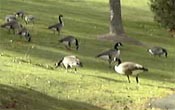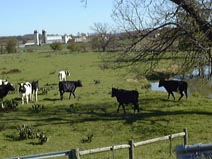
Canada Geese
|
 Cattle near stream |
Problem
Fecal contamination of streamwater and groundwater in the Shenandoah
Valley poses a significant concern to local water-supply managers.
The complex hydrology of this area and the diverse collection of
potential fecal coliform sources make it difficult to link fecal
contamination of water systems to the appropriate animal sources.
An emerging technology, bacteria source tracking (BST), can likely identify
the sources of fecal contamination in these systems.
Knowledge of the sources of fecal contamination will aid in the
development of effective water-protection strategies. Although potentially
powerful, bacteria source tracking is relatively new and no consensus is
available regarding which method (or combination of methods) is most
appropriate for a given situation.
Objective
This study will compare the ability of seven bacteria source tracking
methods to discriminate Escherichia coli isolates from feces of nine
different source-animal categories.
Relevance
and Benefits
Information and knowledge gained from this
study will advance the field of bacteria source tracking.
The evaluation and comparison of bacteria source tracking methods
will provide information that will help investigators across the Nation
choose appropriate techniques for determining sources of bacteria in natural
waters.
Approach
The source tracking methods being compared include ribotyping with HindIII;
ribotyping with EcoRI and PvuII; antibiotic resistance
analysis; pulsed-field gel electrophoresis with Not1; sole source
carbon utilization with BIOLOG; rep-PCR with REP primers; and rep-PCR with
BOX primers. These seven
methods are being evaluated on their ability to correctly identify 200 blind
isolates using a library of 900 known-source isolates.
The
known-source library was developed using fecal samples collected from nine
sources: humans, dogs, beef cows, dairy cows, swine, chickens, horses,
white-tailed deer, and geese. The
collection of blind challenge isolates will test:
·
accuracy
with new isolates from the nine sources represented in the known library,
·
precision
with replicates from the original known-source library, and
·
robustness
with a collection of new sources that are not represented in the
known-source
library (such as mice, cats, goats, and llamas).
Method
performance will be assessed by the rate of correct classification of
isolates within each source group, the rate of false identification within
each source group, and the ability of each method to handle the
unrepresented sources.
